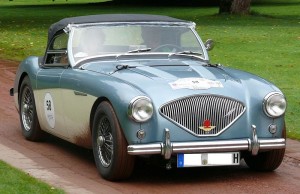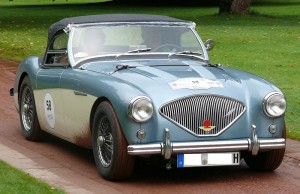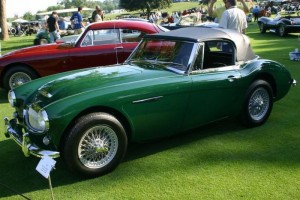Austin-Healey 3000: Rule Britannia!
In a quest to define the quintessential postwar British roadster, the Austin-Healey 3000 is surely a top contender. Built from 1959 until the end of 1967, this swanky six-cylinder sports car pulled the 1950s about as far into the 1960s as it could. The car’s low, curvy profile and throaty six-cylinder engine endowed it with a timelessly British persona beloved by classic car buffs.
The Jaguar E-Type might have revolutionized sports car design in 1961, but that didn’t stop sports car enthusiasts from embracing the Austin-Healey 3000, which was by then a decade-old design. Austin was a full-line carmaker that had merged with Morris in the early 1950s, and in the 1960s both were absorbed into the mess that was British Leyland.
The “Healey” part was Donald Healey, a racer and car designer who had started his own boutique carmaker in 1945. Healey built coupes, convertibles, “saloons” and the cycle-fender Silverstone sports car.
When Donald Healey met the head of Nash-Kelvinator, George W. Mason, on the Queen Elizabeth ocean liner, the two agreed to a plan to use Nash engines in a Healey chassis, resulting in the Nash-Healey sports car in 1951. A year later, Healey built a prototype sports car based on British Austin A90 sedan parts, and Austin made a deal to produce it as the Austin-Healey.
Jensen Connection
Austin-Healey bodies were contract-built by Jensen in West Bromwich, England (which later made the Interceptor luxury model), and cars were assembled at the MG factory. Interestingly, the car that became the 1955 MGA had originally been proposed as an Austin.
The Austin-Healey 100 was so named for its 100-mph top speed, courtesy of a big 2.6-liter inline four-cylinder engine making 90 horsepower. It was teamed to a three-speed manual transmission with overdrive, and then a four-speed with overdrive in 1955.
(photo by Stahlkocher)
The Austin-Healey 100 evolved into the 100-6 in 1956 with the 2.6-liter C-Series pushrod six-cylinder engine used in other Austin models. The basic chassis with leaf-spring rear axle continued, but wheelbase was stretched by two inches (to 92 in.) to accommodate the larger engine and also to offer 2+2 seating.
And then, the Austin-Healey 3000
Customers asked for more performance, and Austin obliged with a 2.9-liter version of the engine making 124 horsepower. The car became the Austin-Healey 3000 Mk. I in 1959. Enthusiasts later referred to it as “the Big Healey,” since it had acquired a “little brother,” the Austin-Healey Sprite, the year before.
The two-seat, 2,600-pound Austin-Healey 3000 had the code number BN7, and the 2+2 was the BT7. Among options were a removable hardtop, wire wheels and a heater. As with other British sports cars, the U.S. market proved to be the Austin-Healey’s lifeblood, with some 90 percent being sent here by the early 1960s.
In 1961, the Austin-Healey 3000 took on the “Mk. II” designation with new triple SU carburetors and other tweaks to boost output to 132 horsepower. Styling changes included a vertical-bar grille, and power brakes became available. The bigger change came for 1962, with a Mk. IIa model (also known as the BJ7) featuring roll-up windows, a curved windshield and a true convertible top. Zero-to-60, at about 10.5 seconds, was still not much quicker than four-cylinder Triumphs.
(photo by Doug Wilkinson)
The final, and many say finest, iteration of the Austin-Healey 3000 came for 1964. Code-named BJ8, the new model was more luxurious, with a burled walnut dashboard that moved the speedometer and tachometer from the center of the dash to the more conventional location in front of the driver. The convertible top could be raised from inside the car, and the rear seat backrest could be folded down to be a carpeted luggage shelf.
Bigger carburetors boosted engine output to 150 hp, good for a 120-mph top speed. Power brakes became standard.
Nearly 43,000 of the total 66,000 “Big Healeys” made were the Austin-Healey 3000, and of those, the Mk. III (or BJ8) accounted for 17,712. A few years later, Healey collaborated with Jensen to build a kind of successor, the Jensen-Healey, which was powered by a Lotus four-cylinder engine.
In 2018, the best Austin-Healey 3000s can exceed $100,000.
Why you’d want an Austin-Healey 3000:
A unique chapter in British sports car history.
Sounds as good as it looks.
More accessible than a Jaguar E-Type, easier to maintain.
Tweed driving cap not required, but recommended.


